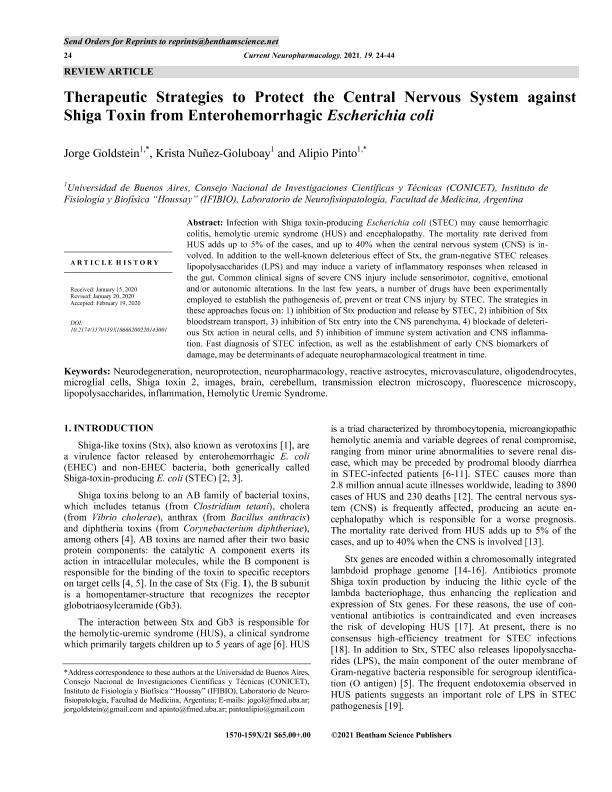Artículo
Therapeutic strategies to protect the central nervous system against shiga toxin from enterohemorrhagic escherichia coli
Fecha de publicación:
02/2020
Editorial:
Bentham Science Publishers
Revista:
Current Neuropharmacology
ISSN:
1570-159X
Idioma:
Inglés
Tipo de recurso:
Artículo publicado
Clasificación temática:
Resumen
Infection with Shiga toxin-producing Escherichia coli (STEC) may cause hemorrhagic colitis, hemolytic uremic syndrome (HUS) and encephalopathy. The mortality rate derived from HUS adds up to 5% of the cases, and up to 40% when the central nervous system (CNS) is in-volved. In addition to the well-known deleterious effect of Stx, the gram-negative STEC releases lipopolysaccharides (LPS) and may induce a variety of inflammatory responses when released in the gut. Common clinical signs of severe CNS injury include sensorimotor, cognitive, emotional and/or autonomic alterations. In the last few years, a number of drugs have been experimentally employed to establish the pathogenesis of, prevent or treat CNS injury by STEC. The strategies in these approaches focus on: 1) inhibition of Stx production and release by STEC, 2) inhibition of Stx bloodstream transport, 3) inhibition of Stx entry into the CNS parenchyma, 4) blockade of deleterious Stx action in neural cells, and 5) inhibition of immune system activation and CNS inflamma-tion. Fast diagnosis of STEC infection, as well as the establishment of early CNS biomarkers of damage, may be determinants of adequate neuropharmacological treatment in time.
Palabras clave:
BRAIN
,
CEREBELLUM
,
FLUORESCENCE MICROSCOPY
,
HEMOLYTIC UREMIC SYNDROME
,
IMAGES
,
INFLAMMATION
,
LIPOPOLYSACCHARIDES
,
MICROGLIAL CELLS
,
MICROVASCULATURE
,
NEURODEGENERATION
,
NEUROPHARMACOLOGY
,
NEUROPROTECTION
,
OLIGODENDROCYTES
,
REACTIVE ASTROCYTES
,
SHIGA TOXIN 2
,
TRANSMISSION ELECTRON MICROSCOPY
Archivos asociados
Licencia
Identificadores
Colecciones
Articulos(IFIBIO HOUSSAY)
Articulos de INSTITUTO DE FISIOLOGIA Y BIOFISICA BERNARDO HOUSSAY
Articulos de INSTITUTO DE FISIOLOGIA Y BIOFISICA BERNARDO HOUSSAY
Citación
Goldstein Raij, Jorge; Nuñez Goluboay, Krista; Vasconcelos Esteves Pinto, Alipio; Therapeutic strategies to protect the central nervous system against shiga toxin from enterohemorrhagic escherichia coli; Bentham Science Publishers; Current Neuropharmacology; 19; 1; 2-2020; 24-44
Compartir
Altmétricas




